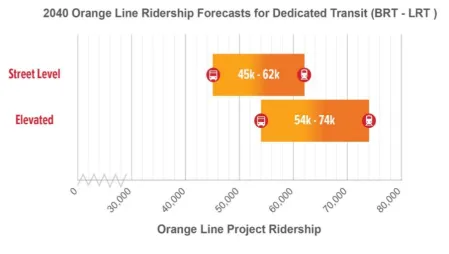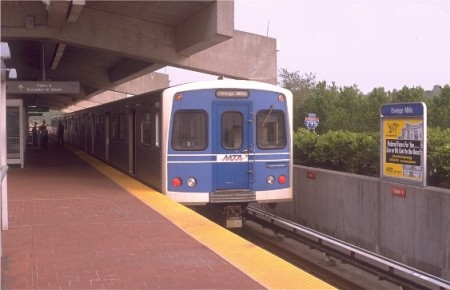
Project Connect study: Ridership potential, capacity advantages push light rail into lead
31 January 2020
Chart shows 2040 forecast ridership for both surface (top bar) and grade-separated (lower bar) options of BRT (left end of each bar) and LRT (right end of each bar). In both cases, LRT ridership substantially exceeds that of BRT. That disparity, plus capacity limitations of BRT, seem to tip scales toward LRT. Graphic: Project Connect (click to enlarge).
♦
In what appears to be a dramatic turn in the saga of Austin’s Project Connect planning process, Austin civic leaders, Capital Metro’s Board, and the team of Project Connect (Capital Metro’s major transit investment planning program) appear to have embraced a planning scenario backing light rail transit (LRT) for both the Orange Line (North Lamar-Guadalupe-South Congress) and Blue Line (downtown-East Riverside-ABIA).
Consensus for this option seemed to emerge during and after a joint Austin City Council/Capital Metro Board work session on 14 January. According to a report in the Austin American Statesman of that date, while LRT would cost more to build than a bus rapid transit (BRT) alternative, “a Cap Metro analysis found the [BRT] system would reach its capacity in 2040.”
In comparison, rail would offer much more potential for passenger growth. Maximum capacity for ridership on a bus rapid transit system would be reached less than a decade from when the system is completed — a fact that doomed it as an option.
Bus rapid transit “does not work … and the analysis shows that now,” Council Member Jimmy Flannigan said. “It doesn’t have the capacity we need.”
Advocates for an LRT starter line serving the Orange Line corridor have long predicted the enormous ridership potential of this route, and Project Connect’s ridership forecasts, based on the Federal Transit Administration (FTA) STOPS model integrated with a locally developed model used by the Capital Area Metropolitan Planning Organization (CAMPO), bear out these community predictions. According to Project Connect’s working forecasts in their operations & maintenance documentation, LRT ridership is projected at unusually high levels for a single new starter line.
• For the year 2028, typical weekday ridership is projected at more than 54,200 for a 50% grade separated (elevated or subway) option, and over 47,200 for a 90% surface option.
• For the year 2040, typical ridership is projected at more than 73,500 for a 50% grade separated option, and over 61,600 for a 90% surface option.
The significance of these Orange Line ridership projections for a single starter line can be assessed by placing them in perspective with ridership experienced by the original single lines of other relatively new major rail rapid transit (RRT, “heavy rail”) and LRT projects, for which data has been readily available. (Weekday ridership data from National Transit Database and American Public Transportation Association.)
• Light rail lines — Los Angeles (1993) 36,600; Denver (1996) 13,500; St. Louis (2005) 40,900; Dallas (1998) 36,700; Salt Lake City (2002) 31,400; Minneapolis (2005) 25,700; Houston (2005) 36,700
• Rail rapid transit (“heavy rail”) lines — Philadelphia-Lindenwold (2019) 38,900; Miami (2019) 59,000; Baltimore 38,400.

For a single-line new-start project, projected 2040 ridership for Orange Line LRT alternative seems to exceed that of even several heavy metro lines, such as this one in Baltimore. Photo: Doug Grotjahn.
It can be seen that the Orange Line projected ridership, if achieved, would fall in the range of some of the highest-ridership new single lines, both LRT and RRT, in the USA, and possibly could count as the highest achieved by any new LRT project in this country.
As Project Connect’s planning proceeds further, attention is focusing on critical details, including fine-tuning and finalizing capital cost estimates that would impact a major municipal bond election proposed for this coming November. Current estimates for the complete Capital Metro service area system, including numerous additional corridors with lighter BRT operations, regional rail services, and other essential transit services as well as the LRT lines, range between $3.8 and $9.4 billion, depending on options such as percentage of surface alignment vs. proposed elevated or subway segments.
■

Leave a comment